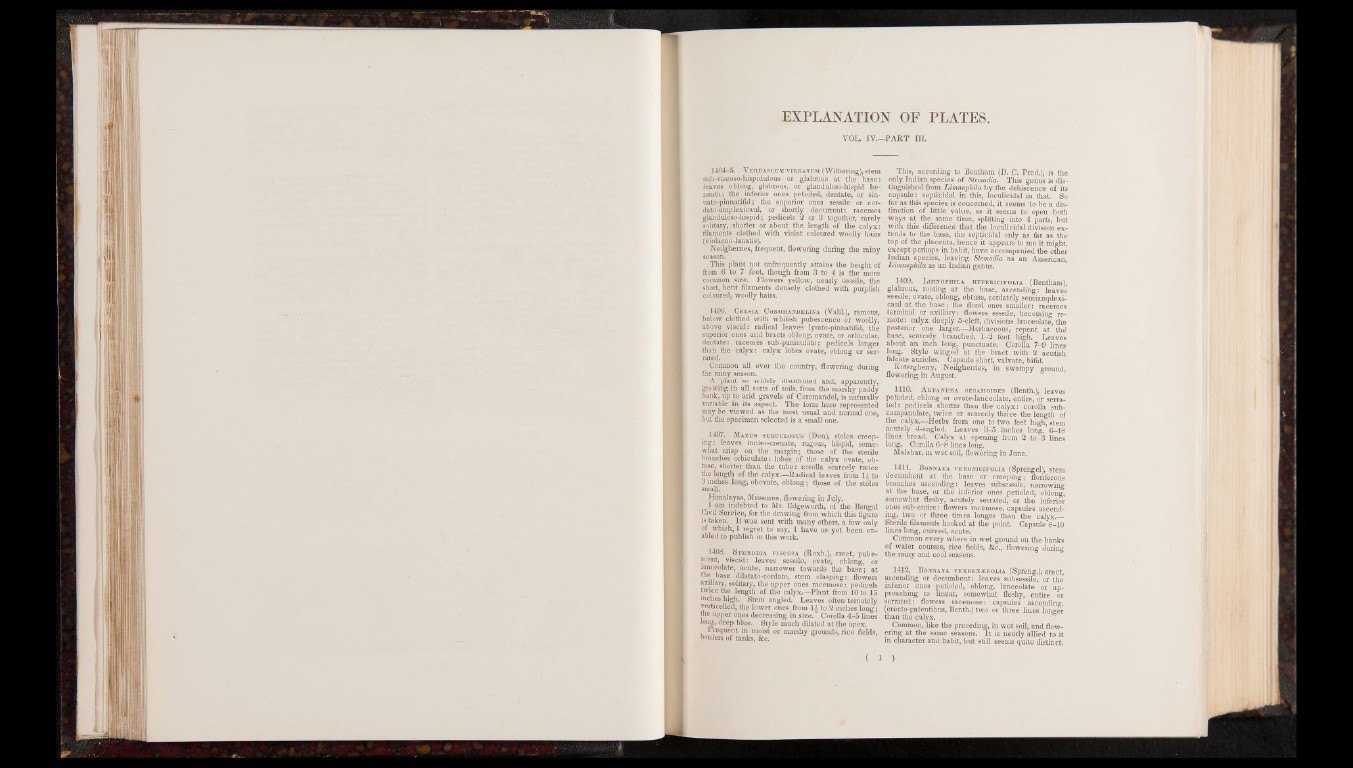
EXPLANATION OF PLATES.
VOL. IV.—PART III.
1404-5. Verb a scum virgatum (Withering), stem
sub-viscoso-hispidulous or glabrous at the base:
leaves oblong, glabrous, or glanduloso-hispid beneath;
the inferior ones petioled, dentate, or sin-
uato-pinnatifid; the superior ones sessile or cor-
dato-amplexicaul, or shortly decurrent: racemes
glanduloso-hispid; pedicels 2 or 3 together, rarely
solitary, shorter or about the length of the calyx:
filaments clothed with violet coloured woolly hairs
(violaceo-lanatis).
Neilgherries, frequent, flowering during the rainy
season.
This plant not (infrequently attains the height of
from 6 to 7 feet, though from 3 to 4 is the more
common size. Flowers yellow, nearly sessile, the
short, bent filaments densely clothed with purplish
coloured, woolly hairs.
1406. Celsia Coromandelina (Vahl.), ramous,
below clothed with whitish pubescence or woolly,
above viscid: radical leaves lyrato-pinnatifid, the
superior ones and bracts oblong, ovate, or orbicular,
dentate: racemes sub-paniculate; pedicels longer
than the calyx: calyx lobes ovate, oblong or serrated.
Common all over the country, flowering during
the rainy season.
A plant so widely distributed and, apparently,
growing in all sorts of soils, from the marshy paddy
bank, up to arid gravels of Coromandel, is naturally
variable in its aspect. The form here represented
may be viewed as the most usual and normal one,
but the specimen selected is a small one.
1407. Mazus surculosus (Don), stoles creeping:
leaves inciso-crenate, rugous, hispid, somewhat
crisp on the margin; those of the sterile
branches prbiculate: lobes of the calyx ovate, obtuse,
shorter than the tube: corolla scarcely twice
the length of the calyx.—Radical leaves from to
3 inches long, obovate, oblong; those of the stoles
small.
Himalayas, Mussuree, flowering in July.
I am indebted to Mr. Edgeworth, of the Bengal
Civil Service, for the drawing from which this figure
is taken. It was sent with many others, a few only
of which, I regret to say, I have as yet been enabled
to publish in this work.
1408. S temodia viscosa (Roxb.), erect, pubescent,
viscid: leaves sessile, ovate, oblong, or
lanceolate, acute, narrower towards the base; at
the base dilatato-cordate, stem clasping: flowers
axillary, solitary, the upper ones racemose: pedicels
twice the length of the calyx.—Plant from 10 to 15
inches high. Stem angled. Leaves often temately
verticelled, the lower ones from 1£ to 2 inches long;
the upper ones decreasing in size. Corolla 4 -5 lines
long, deep blue. Style much dilated at the apex.
Frequent in moist or marshy grounds, rice fields,
borders of tanks, &c.
This, according to Bentham (D. C. Prod.), is the
only Indian species of Stemodia. This genus is distinguished
from Limnophila by the dehiscence of its
capsule: septicidal in this, loculicidal in that. So
far as this species is concerned, it seems to be a distinction
of little value, as it seems to open both
ways at the same time, splitting into 4 parts, but
> with this difference that the loculicidal division extends
to the base, the septicidal only as far as the
top of the placenta, hence it appears to me it.might,
except perhaps in habit, have accompanied the other
Indian species, leaving Stemodia as an American,
Limnophila as an Indian genus.
1409. Limnophila htpericipolia (Bentham),
glabrous, rooting at the base, ascending: leaves
sessile, ovate, oblong, obtuse, cordately semiamplexi-
caul at the base; the floral ones smaller: racemes
terminal or axillary: flowers sessile, becoming remote:
calyx deeply 5-cleft, divisions lanceolate, the
posterior one larger.—Herbaceous, repent at the*
base, scarcely branched, 1-2 feet high. Leaves
about an inch long, punctuate. Corolla 7 -9 lines
long. Style winged at the bract" with 2 acutish
falcate auricles. Capsule short, valvate, bifid.
Kotergherry, Neilgherries, in swampy ground,
flowering in August.
1410. Artanema sesamoides (Benth.), leaves
petioled, oblong or ovate-lanceolate, entire, or serrated:
pedicels shorter than the calyx: corolla sub-
campanulate, twice or scarcely thrice the length of
the calyx.—Herbs from one to two feet high, stem
acutely 4-angled. Leaves 3 -5 inches long, 6-18
lines broad. Calyx at opening from 2 to 3 lines
long. Corolla 6 -8 lines long.
Malabar, in wet soil, flowering in June.
1411. Bonnata veronicifolia (Sprengel), stem
decumbent at the base or creeping; floriferous
branches ascending: leaves subsessile, narrowing
at the base, or the inferior ones petioled, oblong,
somewhat fleshy, acutely serrated, or the inferior
ones sub-entire: flowers racemose, capsules ascending,
two or three times longer than the calyx.—
Sterile filaments hooked at the point. Capsule 8-10
lines long, curved, acute.
Common every where in wet ground on the banks
of water courses, rice fields, &c., flowering during
the rainy and cool seasons.
1412. Bonnasa verben.efolia (Spreng.), erect,
ascending or decumbent: leaves subsessile, or the
inferior ones petioled, oblong, lanceolate or approaching
to linear, somewhat fleshy, entire or
serrated: flowers racemose: capsules ascending,
(erecto-patentibus, Benth.) two or three lines longer
than the calyx.
Common, like the preceding, in wet soil, and flowering
at the same seasons. It is nearly allied to it
in character and habit, but still seems quite distinct.
( )